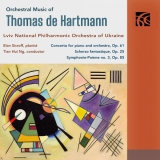03/06/2022
![]() Thomas de Hartmann: Klavierkonzert op. 61 + Symphonie-Poème Nr. 3, op. 85 + Scherzo-fantastique, op. 25; Elan Sicroff, Klavier, Lviv National Philharmonic Orchestra of Ukraine, Tian Nui Ng; 1 CD Nimbus Alliance NI6429; Aufnahme 09.2021, Veröffentlichung 03.06.2022 (70’59) – Rezension von Remy Franck
Thomas de Hartmann: Klavierkonzert op. 61 + Symphonie-Poème Nr. 3, op. 85 + Scherzo-fantastique, op. 25; Elan Sicroff, Klavier, Lviv National Philharmonic Orchestra of Ukraine, Tian Nui Ng; 1 CD Nimbus Alliance NI6429; Aufnahme 09.2021, Veröffentlichung 03.06.2022 (70’59) – Rezension von Remy Franck

Ukrainian composer Thomas de Hartmann (1884-1956) was highly regarded during his lifetime and enjoyed a successful career in France in the 1930s and 1940s. But since his death (in the US) his music has been forgotten.
On this CD, we first hear a very virtuosic piano concerto composed by De Hartmann in 1939, which reminds one of the genre of film music, with touches of Russian romanticism, but also of jazz and blues.
In the colorful and dynamic interpretation of the American pianist Elan Sicroff and the Lviv National Philharmonic Orchestra of Ukraine under the Singapore-born Tian Nui Ng, the concerto becomes very attractive.
The third symphony, Symphonie-Poème, was composed after Thomas de Hartmann and his wife Olga emigrated to New York in 1950.
The work has three contrasting movements, all inspired by the novel ‘In the Woods’ by Russian writer Pavel Melnikov-Pechersky (1818-1883). The first movement describes the legend of Bolotnitsa, a beautiful swamp girl who seduces men and draws them into the swamp.
The second movement tells the story of Stroka, the evil fly. De Hartmann’s programmatic note sets the scene: Sometimes, in the hot summer, a swarm of flies hovers around a herd of horses, cattle or deer. Then a nasty fly appears. The animals sense the presence of this fly in the air and run wildly in all directions in indescribable fear. They kick with their hind legs, raise their tails and roar, but nothing can save them from the evil fly, which buzzes around them until one of the animals becomes its victim and falls down exhausted.
After all the dramatically depicted horrors of the first two movements, the third refers to Radoniza (The Feast of Spring). De Hartmann writes: » In the countries near the Volga, The Feast of Spring begins in the holy week after Easter and sometimes until the Feast of St. John. It corresponds to the ancient Feast of Spring in the times of the Pagans, which was called Radoniza. During these festivals, there is dancing and singing, deriving from the Pagan traditions. The youth of the country run through the woods, fields, and rivers to praise Jar-Hmal, the Pagan god of the joy of living. The joyful songs and captivating dances resound until dawn. »
The interpretation is evocative, as Tian Nui Ng cares for the narrative of the imaginatively orchestrated music in a very sensitive way.
The Scherzo Fantastique Op. 25 was composed in 1929, the year De Hartmann parted ways with Gurdjieff, his mentor with whom he studied over a 12-year period and together composed an extensive body of Eastern music. He established himself near Paris and composed film scores under a pseudonym. It is possible that the Scherzo Fantastique was originally intended to be used for a film. The effective piece is reminiscent of L’Apprenti Sorcier by Paul Dukas, but also has oriental features. Like all the other works, it is performed with commitment by the orchestra.
